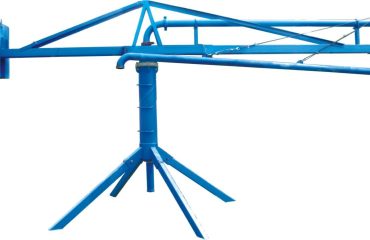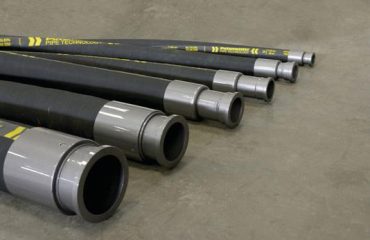ไหลอยู่ในท่อ
การไหลของของไหลในท่อขึ้นอยู่กับแรงดันที่ใช้, รัศมีของท่อและ
ความหนืดของของเหลว. สำหรับของเหลวนิวตัน, การไหลเป็นสัดส่วนโดยตรงกับ
ความหนืด, ซึ่งเป็นค่าคงที่. สำหรับของเหลวที่ไม่ใช่นิวตันที่มีความหนืดที่ขึ้นอยู่กับ
3
เมื่อความเครียดจากการตัด, เช่นยาแนวและคอนกรีต, อัตราการไหลเป็นฟังก์ชันที่ซับซ้อน
ของความหนืด.
มีความหนืด () ของของไหลคืออัตราส่วนของความเค้นเฉือน () ถึงอัตราการเฉือน (̇):
= /. คำจำกัดความนี้สะดวกสำหรับของไหลของนิวตัน, และไม่ใช่แบบนิวตันบางอัน
ของเหลว. ในกรณีอื่นๆ, อย่างไรก็ตาม, วิธีการทางวิศวกรรมในการอธิบายรายละเอียดของกระป๋องของเหลว
ทำให้การวิเคราะห์ง่ายขึ้น. ตัวอย่างเช่นหากของไหลประมาณเป็นของไหลกฎกำลัง, มันสามารถ
อธิบายได้ด้วยสมการ. 1 โดยที่ τ คือความเค้นเฉือน, K ดัชนีความสม่ำเสมอของกฎหมายกำลัง, ̇
อัตราเฉือน, เลขชี้กำลังกฎกำลัง:
n = Kγt [ 1]
โปรไฟล์ความเร็วที่สอดคล้องกันในท่อกลมจะได้มาจากสมการ 2 [4]:
1 1/
2
(3 1) ( ) 1 ( ) ( 1)
n
พีพี
คิวน์ อาร์ วี อาร์
พี เริน อาร์
+ + = − +
[ 2]
โดยที่ v คือความเร็วของของไหลตามฟังก์ชันของตำแหน่งในแนวรัศมี, R , ในท่อ, ถาม
อัตราการไหลตามปริมาตร, และ Rp รัศมีท่อ. ดัชนีความสม่ำเสมอของกฎกำลังของของไหล, K,
สามารถคำนวณได้โดยใช้สมการต่อไปนี้ 3 [4], ซึ่งต้องใช้แรงดันตกคร่อม
การวัดความยาวที่กำหนด:
3 3 1/
2
n
n
พี
พี คิว เค อาร์
แอลพี
∆ − − =
[ 3]
โดยที่ ∆P คือแรงดันตกคร่อม, และ L ระยะห่างระหว่างเซ็นเซอร์ความดัน. การ
เลขชี้กำลัง n และตัวประกอบ K สามารถหาได้จากสมการเช่นกัน 1 จากรีโอโลยี
การวัดของเหลวผ่านรีโอมิเตอร์ หากมี. แต่สมการ 2 และ 3 สามารถ
ยังใช้เพื่อกำหนด n และ K จากการไหลของท่อด้วย, หากไม่มีรีโอมิเตอร์ที่เหมาะสม.
อัตราเฉือนที่พื้นผิวผนังคำนวณโดยใช้สมการต่อไปนี้ [5, 6]:
3
3 1 ( ) พี
พี
เอ็น คิว อาร์ อาร์
ไม่มี อาร์ ซี
พี
+ = = [ 4]
ความเค้นเฉือนเฉพาะที่คือ
τ = ∆rP L / 2 [ 5]
สมการ 1 ผ่าน 5 อธิบายการไหลของของไหลที่เป็นเนื้อเดียวกันในท่อ.
อย่างไรก็ตาม, คอนกรีตเป็นของเหลวที่ซับซ้อนมากกว่าเนื่องจากมีมวลรวมที่มีความกว้าง
4
ช่วงของขนาด. มวลรวมเหล่านี้มีปฏิสัมพันธ์กับผนังท่อและกันและกัน, การสร้าง
ความไม่สม่ำเสมอในของเหลว. ดังนั้น, การไหลของคอนกรีตในท่อมักเกิดขึ้นเป็นสามชั้น
หรือภูมิภาค [5, 6] ดังแสดงในรูป 1:
• ชั้นสลิปหรือชั้นหล่อลื่น,
• บริเวณหรือชั้นของการตัดเฉือน, และ
• คอนกรีตชั้นในหรือชั้น, เรียกอีกอย่างว่าชั้นการไหลของปลั๊ก
ความหนาของชั้นสลิปขึ้นอยู่กับไทรโบโลยีของวัสดุที่อยู่ติดกัน
ไปที่วัสดุท่อ. Tribology คือ “วิทยาศาสตร์และเทคโนโลยีที่เกี่ยวข้องกับการโต้ตอบ
พื้นผิวมีการเคลื่อนไหวสัมพันธ์กัน, รวมถึงแรงเสียดทาน, การหล่อลื่น, สวมใส่, และการพังทลาย” [7]. การ
ความหนาของ, และโปรไฟล์ความเร็วภายใน, ชั้นตัดขึ้นอยู่กับ
ความหนืดและความเครียดของผลผลิต. ความหนาของชั้นในขึ้นอยู่กับผลผลิต
ความเครียด.
องค์ประกอบและลักษณะทางกายภาพของแต่ละชั้นเป็นเรื่องยากที่จะทราบ.
การแสดงลักษณะเฉพาะของพวกมันจำเป็นต้องแยกวัสดุจากบริเวณที่แตกต่างกัน. การ
ชั้นสลิป/การหล่อลื่นประกอบด้วยซีเมนต์เพสต์เป็นหลักและอาจมีอนุภาคทรายที่มีขนาดเล็กมาก
[8], ในขณะที่ชั้นในมีมวลรวมหยาบ. อีกด้วย, เส้นผ่านศูนย์กลางของชั้นใน
หรือไม่ทราบความหนาของชั้นสลิป. เป็นไปได้ว่าคำทำนายเป็นรูปธรรม
การไหลในท่อจะต้องมีลักษณะเฉพาะของแต่ละชั้น.
รูป 1: โปรไฟล์การไหลของคอนกรีตในท่อ [6]
2.2. สลิปชั้น
กลุ่มวิจัยหลายกลุ่มได้ตรวจสอบชั้นลื่นของการไหลของคอนกรีตใน
ท่อ. ชอย และคณะ. [5, 6] วัดความหนาของชั้นสลิปโดยใช้อัลตราโซนิก
เครื่องมือสร้างโปรไฟล์ความเร็ว (ราคาขายปลีก) ในวงจรสูบน้ำโดยใช้อุปกรณ์ทางอุตสาหกรรมพบว่า
มี 2 ชั้นหนา มม. ตลอดพื้นผิวด้านในของท่อ. อย่างไรก็ตาม, ชั้น
ความหนาอาจแตกต่างกันไปขึ้นอยู่กับสัดส่วนของส่วนผสมและโครงสร้างของท่อ.
แคปแลน [9] รายงานว่าการไหลของคอนกรีตในท่อส่วนใหญ่สัมพันธ์กับ
ความหนืดของชั้นสลิปและคุณสมบัติของชั้นนั้นสามารถวัดได้ด้วยไทรโบเมทรี. เขา
พบว่ามีความสัมพันธ์กันระหว่างคุณสมบัติของวัสดุเทกองตามที่วัดได้ในก
5
รีโอมิเตอร์และคุณสมบัติของชั้นสลิปอ่อนแอ. จาค็อบเซ่น และคณะ. [10] แสดงโดย
โดยใช้คอนกรีตสีที่มีโปรไฟล์ความเร็วของคอนกรีตคล้ายกับปลั๊ก
ไหลเข้าตรงกลางท่อ, และชั้นสลิปที่ไม่เคลื่อนไหว, คล้ายกับที่แสดงในรูป 1.
ควอน และคณะ[11, 12] วัดคุณสมบัติทางรีโอโลยีของคอนกรีตก่อนและหลัง
หลังจากสูบน้ำในขณะที่ติดตามความดันและอัตราการไหลแล้วพบว่าในขณะนั้นมี
ไม่มีความสัมพันธ์กันระหว่างคุณสมบัติทางรีโอโลจีของคอนกรีตเทกอง, เช่น, ความหนืดและผลผลิต
ความเครียด, และอัตราการไหล, มีความสัมพันธ์กันอย่างมากระหว่างคุณสมบัติของชั้นสลิป
และอัตราการไหล. ดังนั้นพวกเขาจึงอนุมานได้ว่าชั้นสลิปเป็นปัจจัยกำหนด
ทำนายว่าคอนกรีตจะไหลเข้าท่อ. จากนั้นพวกเขาก็พัฒนาไทรโบมิเตอร์ต่อไป
นั่นคือรีโอมิเตอร์แบบโคแอกเซียลที่มีบ๊อบเรียบที่ทำจากเหล็กหรือหุ้มด้วยยาง
จำลองชั้นสลิปของท่อ.
โงและคณะ[13] สังเกตได้ว่าชั้นสลิปอยู่ระหว่าง 1 มม. ถึง 9 หนา มม, โดย
การแสดงภาพการไหลของวัสดุในรีโอมิเตอร์. เขาวิเคราะห์เลเยอร์แล้วพบว่ามัน
มีทรายที่มีขนาดอนุภาคน้อยกว่า 0.25 มม.. นี่ย่อมหมายความว่ามี
การอพยพของมวลรวมหยาบจากใกล้ผนังไปยังศูนย์กลางของท่อโดยที่
อัตราเฉือนต่ำกว่าที่พบใกล้ผนัง.
2.3. แรงดันปั้ม
ปัจจัยอีกประการหนึ่งในการสูบน้ำคือแรงดันที่ใช้กับวัสดุในการเคลื่อนย้าย
ผ่านท่อ. ริโอและคณะ. [8] แสดงให้เห็นด้วยการทดสอบการสูบน้ำจำนวนมากว่า
ความสัมพันธ์ระหว่างความดันของปั๊มกับอัตราการไหลของวัสดุนั้นเป็นเส้นตรง:
พี ค คิว = +1 2 [ 6]
ที่ไหน 1 เคและ 2 k คือพารามิเตอร์เชิงประจักษ์สองตัวที่ขึ้นอยู่กับวัสดุและอื่นๆ
เงื่อนไขการทดลอง. ริโอและคณะ. สรุปว่าใช้ได้ทั้ง 2 ตัว
กำหนดลักษณะเฉพาะของส่วนผสม. ริโอและคณะ. [8] ทรงสนับสนุนให้มีความรู้เหล่านี้
พารามิเตอร์สำหรับส่วนผสมเฉพาะและวงจรการสูบสามารถใช้เป็นการควบคุมคุณภาพได้
เครื่องมือเพื่อให้แน่ใจว่าแรงดันที่ใช้นั้นเพียงพอเพื่อให้แน่ใจว่ามีอัตราการไหลที่ต้องการ.
เฟย์สและคณะ. [14] สร้างความสัมพันธ์เชิงประจักษ์ระหว่างความหนืดของพลาสติก
ของคอนกรีตด้วยอัตราการเฉือน 10 s-1 และการไล่ระดับความดันในท่อ. ถ้าเกิดความกดดัน
การไล่ระดับสีต่ำเกินไป, วัสดุจะไม่เคลื่อนที่ผ่านท่อ. เฟย์สกล่าวถึงสองคน
ประเด็นที่เกี่ยวข้องกับการทำนายการไหลในท่อ: 1) อิทธิพลของชั้นลื่นเป็นอย่างมาก
สำคัญ, แต่ยังไม่เข้าใจดีนักและวัดผลได้ยาก; 2) อัตราเฉือนใน
ท่อมีความแตกต่างกันทั้งเชิงพื้นที่และชั่วคราว. ทางออกหนึ่งสำหรับผลกระทบของชั้นสลิป
จะเป็นการวัดคุณสมบัติทางรีโอโลยีของมัน, หากสามารถแยกและสกัดออกมาได้.
การสร้างแบบจำลองการไหลในไปป์อาจช่วยแก้ไขปัญหาที่สองได้. เฟย์สและคณะ. [14] นอกจากนี้
สังเกตว่าการสูบน้ำของคอนกรีตที่รวมตัวในตัวเอง (เอสซีซี) ต้องใช้ที่สูงขึ้น
ความดัน, ในขณะที่ความเครียดของผลผลิตเกือบจะเป็นศูนย์, แต่ความหนืดของพลาสติกจะสูงกว่านั้น
สำหรับคอนกรีตธรรมดา. อาจเนื่องมาจากชั้นสลิป (รูป 1) นั่นจะต้องมี
ความเค้นเฉือนที่สูงขึ้นที่อัตราเฉือนเท่าเดิมเนื่องจากความหนืดที่เพิ่มขึ้น.

manufacture of STEEL PIPE & fittings
T :+86
อีเมล: [email protected]
ท่อเหล็กและอุปกรณ์ บริษัท
มณฑลเหอเป่ย์จังหวัด , จีน


คุณต้อง เข้าสู่ระบบ การแสดงความคิดเห็น.